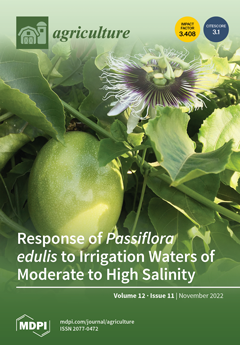Yellow (stripe) rust, caused by
Puccinia striiformis f. sp.
tritici (
Pst), is a major disease of common wheat worldwide. Disease epidemics in Russia have been frequent and destructive, mostly in the North Caucasus. However, over the last 5 years, the significance
[...] Read more.
Yellow (stripe) rust, caused by
Puccinia striiformis f. sp.
tritici (
Pst), is a major disease of common wheat worldwide. Disease epidemics in Russia have been frequent and destructive, mostly in the North Caucasus. However, over the last 5 years, the significance of
Pst has markedly increased in other Russian regions. Therefore, the
Pst virulence diversity was investigated in
Triticum aestivum in six geographically distant regions of the European (North Caucasus, North-West, Low Volga, Central Black Earth region, and Volga-Vyatka) and Asian (West Siberia) parts of Russia, with strongly different climates, environmental conditions, and growing wheat genotypes. Seventy-nine virulence pathotypes among 117 isolates were identified using the 12 Avocet
Yr gene lines (
Yr1,
Yr5,
Yr6,
Yr7,
Yr8,
Yr9,
Yr10, Yr15,
Yr17,
Yr24,
Yr27, and
YrSp) and eight supplemental wheat differentials (Heines VII, Vilmorin 23, Hybrid 46, Strubes Dickkopf, Carstens V, Suwon 92/Omar, Nord Desprez, and Heines Peko). Only four pathotypes occurred in two or more regions. High variability was detected within
Pst populations from Dagestan, Central, North-West, and West Siberia that postulated to form an intrapopulation subdivision of each of them into several subgroups. Most regional virulence groups of pathotypes were closely related, except for several small subgroups of pathotypes from West Siberia, Dagestan, North-West, and Central European regions. All
Pst isolates were avirulent in lines with
Yr5,
Yr10,
Yr15, and
Yr24 genes. Virulence to
Yr17 was detected for several isolates of two pathotypes, one each from the North-West and Low Volga regions. Variation in virulence frequency was observed in other differential lines.
Full article





